Martin’s Lizard
SHARE THIS POST
Few lures in history have been copied more by companies than Jack Martin’s Lizard, according to an opening line in a volume of the company’s history by Robert Slade in his coverage of this lure in his 18-volume book set, The Encyclopedia of Old Fishing Lures.
Slade spent many days over the years combing our files of catalogs, adds and lures, as he compiled this wonderful history of lures. He spent amazing efforts, traveling far and wide to capture the history of smaller companies that are overlooked by collectors of products from major companies.
In the 1940s, Jack H. Martin, of Drumright, Okla., developed a deep-diving bait that was very effective. In 1946, he filed for patents in Canada and the U.S., and was issued a patent in 1949, but our country never approved his application.
The hand-painted baits were first made of cedar wood with glass eyes and were packed in silver boxes with green print that stated, “Martin’s Lizard That Gets the Big Ones.” They were designed to float at rest and go deep on a retrieve, with also a wobbling, rocking and erratic action. Patents were pending in U.S. and Canada and they were “sold only by Jack Martin at Drumright, Okla.”
The instructions found by Bob in our files were originally from the Richard Walton collection, which first included lures in 1909, plus catalogs and papers. I purchased this collection consisting of 4,000 lures, as well as files of history years ago, and continue to add to it.
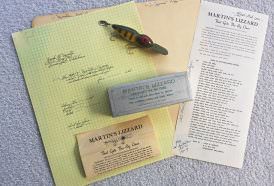
The directions have a caution not to tie the line tight to eye in a bill, as it will “kill the action, tie loose loop or use a small snap.” It adds that after the plug has reached the desired depth, when casting, you need to reel for a few feet then stop and continue this stop-and-go system all the way in. Then they add, reel slow, but not too fast for best results, and, to reel it in slow in shallow water.
Next, they say the plug should hang while fishing in brush, stumps or logs. And, simply slack off on the line and the plug will stand up on its head and float up above obstruction, then you can continue on to the retrieve.
Are you enjoying this post?
You can be among the first to get the latest info on where to go, what to use and how to use it!
The company adds this plug is “made by a fisherman for the fishermen” and says it is something different. There were 32 colors the lure was made in and the price was $1.25 each. Later, the lures were made in 48 colors until 1955, when operations were moved to Stillwater, Okla. The baits were subsequently made of plastic, including a plastic box, but still used the glass eyes for a short time. The color selection was also then shortened to 11 different finishes.
Jack Martin Sr. died in 1970, and his son Jack Jr. took over in Wichita, Kans. He had only made the lures for three years when my friend, the late Jerry Kidwell, bought the business.
Jerry and I were charter members of the Indianapolis Bassmasters, and we shared many good times in our meetings and tournaments throughout the Midwest. He would go on to make the lures in plastic with molded in eyes, and in 28 different finishes.
Jerry died in February 2014, at the age of 59—way too early. May he rest in peace.
Dan Basore is a fishing historian and steward of the history of the sport. In his efforts to preserve fishing history, Basore is always on the lookout for information about early lure makers, old lures, pre- level wind reels, manufacturer catalogs, tournament casting items and the like. If you possess information or materials that can help, please contact Dan Basore, Historical Fishing Display, at 630-393-3474 or 1-800-347-4525.
MWO
SHARE THIS POST
Did you enjoy this post?
You can be among the first to get the latest info on where to go, what to use and how to use it!
Dan Basore
Dan Basore is a fishing historian and steward of the history of the sport. In his efforts to preserve fishing history, he is always on the lookout for information about early lure makers, old lures, pre-level wind reels, manufacturer catalogs, tournament casting items and the like. If you possess information or materials of this kind, please contact him at 630-393-3474 or by email at ollures@aol.com.
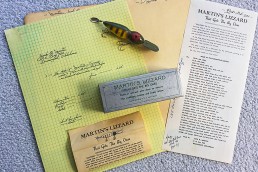
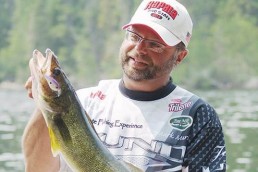
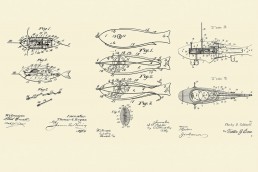
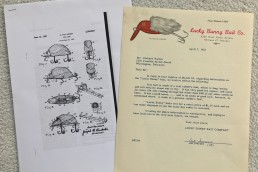
I WAS AMAZED AND DELIGHTED TO SEE YOUR ARTICLE ON THE MARTIN LIZZARD.
I WAS BORNED AND RAISED IN DRUMRIGHT, OKLAHOMA AND KNEW JACK MARTIN PERSONALLY. JACK AND MY DAD JUDSON CHARLTON WORKED AT THE TYDOL REFINERY FOR YEARS. JACK AND MY DAD FISHED TOGETHER IN SOME OF THE SMALL LAKES AROUND DRUMRIGHT. I REMEMBERE DAD TALKING ABOUT JACK USING A BROOM STICK TO WIDDLE OUT THE SHAPE OF THE MARTIN LIZZARD AND TRYING THEM OUT ON THEIR FISHING TRIPS.
JACK WAS A FULL BLOODED AMERICAN INDIAN AND HAD THE DESIRE TO FISH AND HE WANTED TO DESIGN A SPECIAL PLUG FOR BASS FISHING. DAD SAID JACK WORKED ON PERFECTING THE MARTIN LIZZARD AND WOULD TRY SOME THING NEW UNTIL HE PERFECTED THE MARTIN LIZZARD TO HAVE THE SWIMING MOTION HE WANTED. DAD BENEFITTED FROM HIS EFFORTS WHEN JACK USED HIM
TO TEST HIS NEW DESIGN.
WHEN I GRADUATED FROM HIGH SCHOOL AND WENT TO COLLEGE (SEPT 1949) MY FISHING CAME TO A HALT.
IN JANUARY 1951 I JOINED THE AIR FORCE AND WAS DISCHARGE IN OCT 1954 AND RETUTRNED TO DRUMRIGHT, OKLA AND WENT TO COLLEGE AT OKLAHOMA A&M.
IN THE MEAN TIME THE TYDOL REFINERY CLOSED AND DAD FOUND A JOB WITH THE GOVERNMENT AS A PRODUCT INSPECTOR AND MOVE TO COFEEVILLE, KANSAS.
JACK MARTIN HAD MOVED TO STILLWATER, OKLA. SO I LOOKED HIM UP AND FOUND IS PRODUCING THE MARTIN LIZZARD AND SELLING THEM TO VARIOUS SPORTS STORES. I TALKED TO JACK AND HE ASK ME IF I WOULD LIKE TO HELP HIM WITH HIS PRODUCTION OF HIS PLUGS. OF COURSE I AGREED
TO ASSIST HIM IN MY SPARE TIME. HE WOULD PROVIDE ME WITH THE PLUG BODY THAT CAME FROM THE LATHE AND I WOULD INSERT THE BILL IN THE SLOT AND SECURE IT AND SOLDER THE LOOP TO THE BILL AND HE WOULD PAY ME 50 CENTS A COMPLETED PLUG. IT PROVIDED ME WITH SOME SPENDING MONEY.
I ALSO GOT TO TRY. OUT HIS PLUGS ON LAKE CARL BLACKWELL WHICH WAS ABOUT 10 MILES WEST OF STILLWATER, OKLA. I CAUGHT MY FIRST BIG BASS 8 1/2 #S WHAT A THRILL AND IT PROVIDED A GREAT MEAL FOR A COLLEGE STUDENT WHO WAS MARRIED AND HAD ONE CHILD AND DEPENDED ON $135.00 A MONTH, FROM THE GI BILL FOR OUR EXPENSES. BUT WE MADE IT WORK.
I WORKED WITH JACK UNTIL I GRADUATED AND APPRECIATED THE COMPENSATION.
I WILL SHARE WITH YOU A FISHING STORY TO ILLUSTRATE HOW WELL THE MARTIN LIZZARD WAS APPRECIATED BY THE BASS FISHERMEN.
I TALKED MY DAD INTO GOING ON A FISHING TRIP TO BULL SHOALS LAKE IN THE SPRING OF 1957.
WE WENT TO BOAT DOCK 125. WHEN WE ARRIVED WE FOUND THE LAKE TO BE VERY LOW ( ON THE ORDER OF 50 FT). AND THERE WERE NO CABINS AVAILABLE AFTER HARRISON, ARK.. WELL WE AGREED THAT ONE NIGHT DAD TOOK THE FRONT SEAT AND I TOOK THE BACK.
THE NEXT MORNING WE WENT TO THE BOAT DOCK AND RENTED THE LAST BOAT AVAILABLE A 15 FOOT BOAT WITH A 9 1/2 HP MOTOR WHICH AT THE TIME WAS FINE. BEFORE WE WENT OUT I WAS TALKING TO THE BOAT DOCK OPERATOR AND ASK HIM WHAT THEY WERE CATCHING THE MOST FISH ON. HE SAID A MARTIN LIZZARD AND THERE HARD TO COME BY BUT I CAN RENT YOU ONE FOR $5.00 PER DAY. I LOOKED AT HIM I SAID LET ME SHOW YOU MY TACKLE BOX AND I OPENED IT UP AND SHOWED HIM MY COLLECTION OF MARTIN LIZZARDS. HE LOOKED AT MY COLLECTION AND I SAID MAYBE I CAN RENT YOU SOME. HE JUST SHOOK HIS HEAD.
TO END THE STORY. WE CAMPED OUT FOR FOUR NIGHTS, WENT TO A LOCAL GAS STATION AND GOT CANNED GOODS AND EGGS .
THE FISHING WAS EXCELLENT AND WE CAUGHT SOME NICE FISH I GOT AN 8 1/2# AND A 9# BASS AND DAD CAUGHT 7# AND 8# BASS ON THE FISHING TRIP ALL OF THE FISH WERE CAUGHT ON MARTIN LIZZARDS. I STILL HAVE ABOUT 20 MARTIN LIZZARDS IN MY COLLECTION.
WE ALWAYS ADDED A TAIL TO THE MARTIN LIZZARD BY ADDIND A SMALL EYE IN THE REAR OF THE MARTIN LIZZARD AND ADDED A SMALL STRIP OF WHITE RUBBER FROM A BABY DIAPER. THIS WAS PARTICULARLY EFFECTIVE WHEN TROLLING.
THE HELLBENDER IS A COPY OF THE MARTIN LIZZARD BUT I WILL TAKE MY CEDAR BODY MARTIN LIZZARD ANY DAY OVER THE HELLBENDER.
THANKS FOR REMINDING ME OF THE BEST ARTIFICAL LURE IN MY TACKLE BOX.
DON CHARLTON
THANKS FOR THE ARTICLE ON THE MARTIN LIZZARD. TO ME THE NARTIN LIZZARD IS AB ICON OF PLUGS FOR THE AVID BASS FISHERMAN
IF THERE IS A BASS PLUG HALL OF FAME THE MARTIN LIZZARD DESERVES TO BE IN IT.
DON CHARLTON
Hi Don,
Sorry for the delayed reply and thank you for your note sharing your memories of Jack Martin!
Sincerely,
Dave Mull
Digital Editor